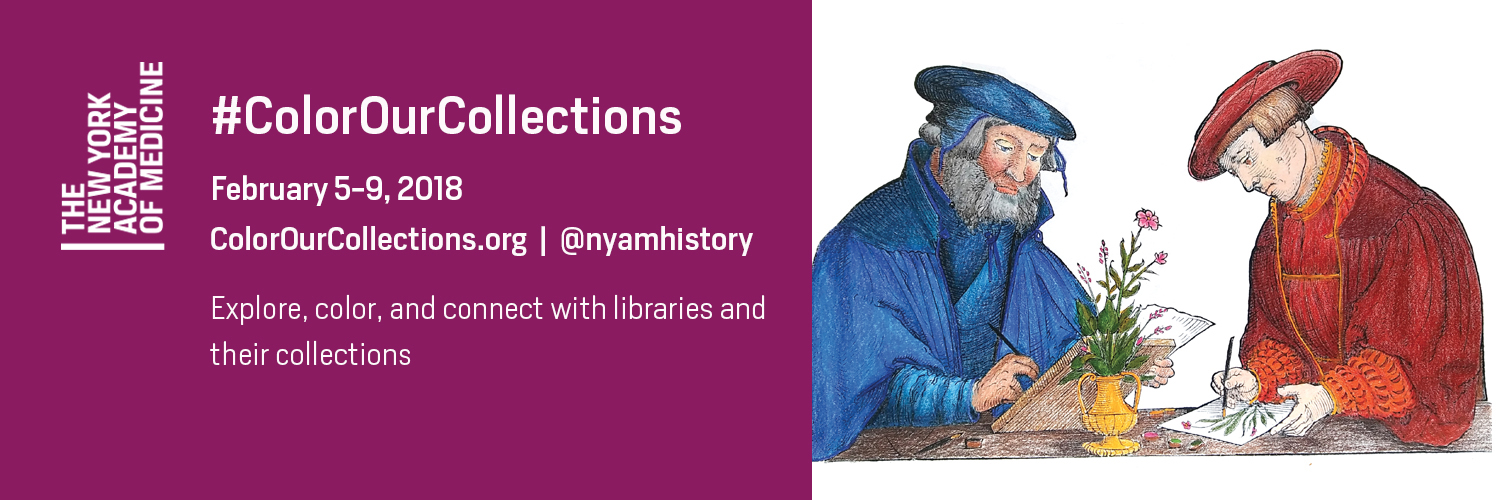I’ve recently received a couple of emails promoting the New York Academy of Medicine’s Color Our Collections week, Febru ary 5-9. I haven’t really paid too much attention to the emails until today when I thought that a post on the diversity blog might be in order. The body of this post takes the form of a colloquy.
ary 5-9. I haven’t really paid too much attention to the emails until today when I thought that a post on the diversity blog might be in order. The body of this post takes the form of a colloquy.
“Color our collections, eh? That sounds like an interesting initiative to highlight diversity in rare materials collections”
“And it’s promoted by the National Academy of Medicine—this is going to be really interesting! I’m sure there is loads of fascinating material relating to people of color in the collections of medical institutions!”
“Just think of all the medical literature surrounding traditional and indigenous medical practices.”
“Yes. I’m also thinking early journals and travel narratives of European medical practitioners as they ventured into new territories and encountered indigenous peoples.”
Click. Scroll.
“Oh, I was wrong! It’s nothing to do with diversity—it’s a bunch of coloring books from libraries”
“But I still want to do a blog post”
“Don’t worry—there will be some coloring books that focus on subjects of interest to the UCI Libraries Diversity Team”
Scroll.
Scroll.
“Where?”
And that, dear readers, is the point. This is a good illustration of the failing of special collections departments–and libraries more generally–in North America and Western Europe (there are some contributions from the UK, France and Poland) to highlight women and people of color from within their collections. In particular, I think, this demonstrates the lack of diversity in what are considered the treasures or highlights of the collections—those materials that are best known to the curators (and thus were converted into coloring books).
A few institutions have contributed coloring books that are perhaps of more relevant interest:
- The Brooklyn Public Library includes the cover of Black News 1 (15), (May 29, 1970). (interestingly, there were several very similar magazine covers in the exhibition ‘We wanted a revolution, black radical women 1965-85’ at the CAAM—this exhibition, which just closed a few weeks ago, was on loan from the Brooklyn Museum)
- The Center for the History of Medicine, Francis A Countway Library of Medicine (Harvard Medical School and Boston Medical Library) has a very impressive image of Dr M Elizabeth Reifsnyder performing surgery (circa 1885) – click through to see the full-sized image and description at the Center for the History of Medicine’s website: An 1881 graduate of the Woman’s Medical College of Pennsylvania, Dr. M. Elizabeth Reifsnyder (1858-1922) worked in Shanghai, China, as both physician and missionary and founded the Margaret Williamson Hospital there in 1885.
“Ok, this is good. I think you’ve made your point.”
“Really? There’s a lot more stuff that I haven’t looked at yet.”
“Yes, but there are also books that need to be cataloged. Let your colleagues make their own discoveries.”
“Yes, that’s a good idea. It would be interesting to hear from them what they think of this initiative—and what in UCI’s collections would do a good job of highlighting diversity inherent in our collections.”
“Yes. Yes it would.”
“Thanks for this opportunity to chat.”
Leave a Reply